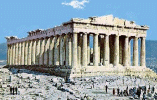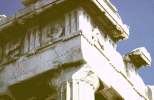The Parthenon |
The Parthenon |
| Iktinos and Kallikrates Parthenon (Temple of Athena Parthenos) Acropolis, Athens, 447-438 BCE | |
 |
The Parthenon is generally considered to be the high point in Greek architecture. It was preserved as religious building for centuries, first as Byzantine church, then as Catholic church, later as a mosque (it even had minaret added). Although the interior was remodeled, the exterior stayed essentially the same until the 17th century when the Turks used it as a powder magazine--and it blew up.
The Parthenon is somewhat larger than earlier Doric temples with eight columns (rather than the more usual six) across front and 17, not 13, along side. Erected in a rather short period of time, it is perfectly constructed with blocks of marble joined so carefully (without mortar) that a knife blade can't be stuck between them. It is a more refined example of the Doric order with numerous optical corrections so that it is adapted to the eye of the spectator. For example, both the base and the entablature rise in a very slight curve (2 3/4" on the facade) so that the building won't appear to sag; columns thicken slightly in the center because if they were mathematically straight, they would appear to have a concavity; columns at the end are slightly thicker and tilt a few inches inward to compensate for visual distortions. |
| Metopes from the Parthenon 447-442 BCE relief sculpture | |
MAS  | Although we think of Greek sculpture as pure white, the Greeks painted their figures and parts of their temples. The triglyphs here were originally blue; the background of the metopes was white but the figures were painted. Each of the 92 metopes is about 4 feet square. They were carved and then inserted in place as the building was constructed. Different subjects are depicted on each of the four faces of the Parthenon. |
 | Metope depicting the contest of the Lapiths and Centaurs south flank of the Parthenon
This depiction battle of the Lapiths and Centaurs is especially relevant to the historical context of the Acropolis building program. Although the subject derives from Greek myth, it also symbolizes the Greek attitude toward the Persians, who had earlier destroyed the Athenian acropolis. The Persian here are represented by the bestial half-horse, half-man centaurs. This Greek myth becomes an allegory for the triumph of reason over barbarism. |
| Frieze of the Parthenon 442-438 BCE relief sculpture | |

|
The continuous frieze of the Parthenon, an Ionic element, runs along the inside of the porch; thus it is hard to see 40 feet up and at a steep angle. It runs along all four sides of the Parthenon for over 500 feet. In the early nineteenth century Lord Elgin, the British ambassador to the Turkish court, was allowed to dismantle much of the frieze and some of the pediment sculptures. Thus, these parts of the sculptural decoration of the Parthenon are now in the British Museum -- popularly known as the Elgin marbles. The British ownership of such an important part of Greece's cultural heritage is a subject of heated debate. Unlike the metopes, which depict mythical events, the frieze depicts the most important religious event in Athens -- the Panathenaic festival. This probably represents the first time in Greek art that a contemporary event was shown. Although no specific individuals are represented, contemporary Athenians ride horseback in procession, lead sacrificial animals, or carry water jugs or olive branches. The center of the east front depicts the actual ceremony. Depicting themselves as democratic citizens honoring their goddess, not servile tribute-bearing Persians, reflects the high opinion the Athenians had of themselves and their way of life. |
All images marked MAS were photographed on location by Mary Ann Sullivan. All other images were scanned from other sources or downloaded from the World Wide Web; they are posted on this password-protected site for educational purposes, at Bluffton College only, under the "fair use" clause of U.S. copyright law.